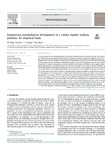Mostrar o rexistro simple do ítem
Engineering morphological development in a robotic bipedal walking problem: An empirical study
| dc.contributor.author | Naya-Varela, M. | |
| dc.contributor.author | Faíña, Andrés | |
| dc.contributor.author | Duro, Richard J. | |
| dc.date.accessioned | 2023-03-27T17:11:12Z | |
| dc.date.available | 2023-03-27T17:11:12Z | |
| dc.date.issued | 2023-03 | |
| dc.identifier.citation | NAYA-VARELA, M., FAINA, A. and DURO, R. J., 2023. Engineering morphological development in a robotic bipedal walking problem: An empirical study. [online]. 2023. Vol. 527, p. 83–99. DOI 10.1016/j.neucom.2023.01.003. Available from: https://www.sciencedirect.com/science/article/pii/S0925231223000115 | es_ES |
| dc.identifier.issn | 0925-2312 | |
| dc.identifier.uri | http://hdl.handle.net/2183/32790 | |
| dc.description | Financiado para publicación en acceso aberto: Universidade da Coruña/CISUG | es_ES |
| dc.description.abstract | [Abstract]: In living beings, the natural development of the body has been shown to facilitate learning. The application of these natural developmental principles in robotics have been considered in different robotic morphologies and scenarios, leading to mixed results. Development was found to be beneficial for learning in some instances, but also irrelevant or detrimental in others. This mix of results and scenarios has allowed researchers to extract some notions about the conditions that must be fulfilled or set to apply morphological development successfully. Notions that we have organized to set a series of design conditions to successfully apply morphological development. Thus, in this article, we are going to focus on the study of one of them that has been frequently addressed by researchers in their studies in very general terms. It can be described as the need to achieve a suitable synergy among the different components involved in the development and learning process: morphological development strategy, controller, task, and learning algorithm. In particular, we have concentrated on empirically determining the influence of five developmental strategies, implemented in different ways, applied at different speeds and deployed in different orders and combinations, over the problem of a NAO robot controlled by an artificial neural network obtained through a neuroevolutionary algorithm learning a bipedal walking task. The results obtained permit providing a more detailed description of what a suitable synergy implies and how it can be utilized to design more successful morphological developmental processes to improve robot learning. | es_ES |
| dc.description.sponsorship | Xunta de Galicia ; EDC431C-2021/39 | es_ES |
| dc.description.sponsorship | Research supported by the European Commission Horizon program PILLAR-Robots project, grant 101070381, the Xunta de Galicia and the European Regional Development Funds under grant EDC431C-2021/39 and the Spanish Science and Education Ministry through grant PID2021-126220OB-100. We wish to acknowledge the support received from the Centro de Investigación de Galicia ‘‘CITIC”, funded by Xunta de Galicia and the European Union (European Regional Development Fund-Galicia 2014-2020 Program), by grant ED431G 2019/01 and the Centro de Supercomputación de Galicia (CESGA) | es_ES |
| dc.description.sponsorship | Xunta de Galicia; ED431G 2019/01 | es_ES |
| dc.language.iso | eng | es_ES |
| dc.publisher | Elsevier B.V. | es_ES |
| dc.relation | info:eu-repo/grantAgreement/EC/HE/101070381 | es_ES |
| dc.relation | info:eu-repo/grantAgreement/MICINN/Plan Estatal de Investigación Científica y Técnica y de Innovación 2021-2024/PID2021-126220OB-100/ES/REPRESENTACION EN APRENDIZAJE CONTINUO Y ABIERTO EN ROBOTS INTELIGENTES | |
| dc.relation.uri | https://doi.org/10.1016/j.neucom.2023.01.003 | es_ES |
| dc.rights | Attribution-NonCommercial-NoDerivatives 4.0 International (CC BY-NC-ND 4.0) | es_ES |
| dc.rights.uri | http://creativecommons.org/licenses/by-nc-nd/3.0/es/ | * |
| dc.subject | Morphological development | es_ES |
| dc.subject | Robot learning | es_ES |
| dc.subject | Bipedal walking | es_ES |
| dc.subject | Engineering design | es_ES |
| dc.title | Engineering morphological development in a robotic bipedal walking problem: An empirical study | es_ES |
| dc.type | info:eu-repo/semantics/article | es_ES |
| dc.rights.access | info:eu-repo/semantics/openAccess | es_ES |
| UDC.journalTitle | Neurocomputing | es_ES |
| UDC.volume | 527 | es_ES |
| UDC.startPage | 83 | es_ES |
| UDC.endPage | 89 | es_ES |
| dc.identifier.doi | https://doi.org/10.1016/j.neucom.2023.01.003 |
Ficheiros no ítem
Este ítem aparece na(s) seguinte(s) colección(s)
-
CIT-GII - Artigos [38]
-
OpenAIRE [340]






